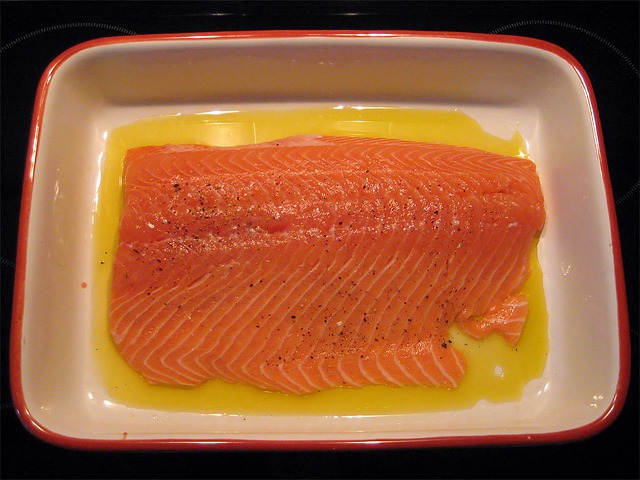 Humans require two fatty acids to be present in their diet. These fatty acids, alpha linolenic acid (ALA, C18:3 (n-3)) and linoleic acid (LA, C18:2 (n-6)) belong to the omega-3 and omega-6 family of polyunsaturated fatty acids, respectively. A daily intake of these fats, or metabolites of them, are required in order for normal cell function to proceed. Deficiencies of either fatty acid results in cellular changes that reflect a transition to disease. In particular, both ALA and LA are integral to the regulation of inflammation, and low intakes of either can increase the risk of inflammatory conditions, with subsequent associated oxidative stress. However, more important than the absolute amounts of the essential fatty acids, it is the ratio of ALA to LA in the diet that determines the subsequent production of inflammatory conditions. It has been estimated that a ratio of around 1 gram of ALA for every 3 grams of LA may be required. However, some traditional diets in the World, such as the Eskimo diet, contain higher amounts of omega-3.
Humans require two fatty acids to be present in their diet. These fatty acids, alpha linolenic acid (ALA, C18:3 (n-3)) and linoleic acid (LA, C18:2 (n-6)) belong to the omega-3 and omega-6 family of polyunsaturated fatty acids, respectively. A daily intake of these fats, or metabolites of them, are required in order for normal cell function to proceed. Deficiencies of either fatty acid results in cellular changes that reflect a transition to disease. In particular, both ALA and LA are integral to the regulation of inflammation, and low intakes of either can increase the risk of inflammatory conditions, with subsequent associated oxidative stress. However, more important than the absolute amounts of the essential fatty acids, it is the ratio of ALA to LA in the diet that determines the subsequent production of inflammatory conditions. It has been estimated that a ratio of around 1 gram of ALA for every 3 grams of LA may be required. However, some traditional diets in the World, such as the Eskimo diet, contain higher amounts of omega-3.

Fish oils are an important dietary source of omega-3 fatty acids. Increasing the intake of fish oils allows correction of the omega-6 to omega-3 fatty acid ratio in those who over consume omega-6 fatty acids. However, it is also important to lower intakes of the omega-6 fatty acids concomitantly.
The exact ratio is therefore not fully understood. However, it has become apparent that the typical Western diet, the diet consumed by most of the Western nations, is far too rich a source of omega-6 fatty acids. Estimates have been made of the typical Western diet and studies suggest that the ratio of ALA to LA is around 1:10 or 20. This provides far too much omega-6 fat, and as a result the typical Western diet is considered inflammatory. This is reflected in the high risk of developing Western lifestyle diseases in those who follow the typical Western diet. In particular, cardiovascular disease has a strong pro-inflammatory component, that may relate partially to the ingestion of too much LA. The current recommendation to consume less vegetable oil (a rich source of omega-6 fatty acids) and more fish oils (a rich source of omega-3 fatty acids) is an attempt to redress the imbalance of these fatty acids in the diet of most Westerners. Fish oils both from fish and from supplements have strong anti-inflammatory effects for this reason.
Pulse wave velocity is the rate at which the arterial pulse propagates through the vasculature of the individual. Pulse wave velocity increases with age because the velocity is associated with arterial stiffness. Therefore pulse wave velocity can be a marker for cardiovascular disease, because as arterial stiffness proceeds, the risk of cardiovascular disease also increases. Arterial stiffness can be affected by the inflammatory conditions in the individual. Inflammation results in the generation of free radicals, and these cause oxidation of tissues and the depletion of antioxidants, a condition known as oxidative stress. Oxidative stress in turn increases arterial stiffness because it inhibits the synthesis of nitric oxide in the arterial wall, and nitric oxide is required for the correct dilation of arteries by allowing relaxation of the musculature in the artery wall. Relaxation of the musculature is an important part of the cycle of contraction and relaxation involved in pulse wave generation.

More important that the absolute amounts of omega-3 and omega-6 fatty acids is the ratio of the two. For every gram of omega-3 fat, about 3 grams of omega-6 fat should be consumed. An imbalance of this ratio leads to inflammation and disease.
Researchers can measure pulse wave velocity and relate the results to the levels of omega-3 and omega-6 fatty acids, allowing them to determine the associations between the fatty acids and the risk of developing arterial stiffness. For example, in one study, a group of researchers analysed the fatty acids contained within phospholipids in the blood of a group of elderly subject (~75 years). The researchers then measured the pulse wave velocity in the subjects. The results showed that concentrations of eicosapentaenoic acid (EPA, C20:5 (n-3)) and docosahexaenoic acid (DHA, C22:6 (n-3)), were associated with a lower pulse wave velocity in the carotid artery. Both EPA and DHA are metabolites of ALA, and reflect the omega-3 fatty acid status of the individual. In contrast, the levels of total omega-6 fatty acids and LA in the blood of the subjects was associated with a higher pulse wave velocity. The omega-3 to omega-6 ratio of the blood may therefore be associated with the risk of developing cardiovascular disease.
Eat Well, Stay Healthy, Protect Yourself
RdB
